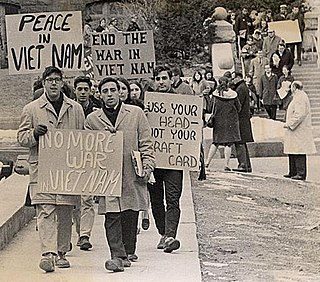
A counterculture is a culture whose values and norms of behavior differ substantially from those of mainstream society, sometimes diametrically opposed to mainstream cultural mores. A countercultural movement expresses the ethos and aspirations of a specific population during a well-defined era. When oppositional forces reach critical mass, countercultures can trigger dramatic cultural changes. Countercultures differ from subcultures.

A subculture is a group of people within a cultural society that differentiates itself from the values of the conservative, standard or dominant culture to which it belongs, often maintaining some of its founding principles. Subcultures develop their own norms and values regarding cultural, political, and sexual matters. Subcultures are part of society while keeping their specific characteristics intact. Examples of subcultures include BDSM, hippies, hipsters, goths, steampunks, bikers, punks, skinheads, gopnik, hip-hoppers, metalheads, cosplayers, otaku, otherkin, furries, hackers and more. The concept of subcultures was developed in sociology and cultural studies. Subcultures differ from countercultures.

Youth culture refers to the societal norms of children, adolescents, and young adults. Specifically, it comprises the processes and symbolic systems that are shared by the youth and are distinct from those of adults in the community.

Mod, from the word modernist, is a subculture that began in late 1950s London and spread throughout Great Britain, eventually influencing fashions and trends in other countries. It continues today on a smaller scale. Focused on music and fashion, the subculture has its roots in a small group of stylish London-based young men and women in the late 1950s who were termed modernists because they listened to modern jazz. Elements of the mod subculture include fashion ; music and motor scooters. In the mid-1960s when they started to fade out, the subculture listened to rock groups with R&B influences such as the Who and Small Faces. The original mod scene was associated with amphetamine-fuelled all-night jazz dancing at clubs.
The 20th century saw the rise and fall of many subcultures.
Adolescent cliques are cliques that develop amongst adolescents. In the social sciences, the word "clique" is used to describe a group of 3 to 12 "who interact with each other more regularly and intensely than others in the same setting". Cliques are distinguished from "crowds" in that their members socially interact with one another more than the typical crowd. Crowds, on the other hand, are defined by reputation. Although the word 'clique' or 'cliquey' is often used in day-to-day conversation to describe relational aggression or snarky, gossipy behaviors of groups of socially dominant teenage girls, that is not always accurate. Interacting with cliques is part of normative social development regardless of gender, ethnicity, or popularity. Although cliques are most commonly studied during adolescence and in educational settings, they can exist in all age groups and settings.

In criminology, subcultural theory emerged from the work of the Chicago School on gangs and developed through the symbolic interactionism school into a set of theories arguing that certain groups or subcultures in society have values and attitudes that are conducive to crime and violence. The primary focus is on juvenile delinquency because theorists believe that if this pattern of offending can be understood and controlled, it will break the transition from teenage offender into habitual criminal. Some of the theories are functionalist, assuming that criminal activity is motivated by economic needs, while others posit a social class rationale for deviance.
Dick Hebdige is an English media theorist and sociologist, and a professor emeritus of art and media studies at the University of California, Santa Barbara, where he taught from 2004 to 2021. His work is commonly associated with the study of subcultures, and its resistance against the mainstream of society. His current research interests include media topographies, desert studies, and performative criticism.
Teenage rebellion is a part of social development in adolescents in order for them to develop an identity independent from their parents or family and a capacity for independent decision-making. Teenage rebellion usually begins at around 13 years old, while for some it may start to happen 1-2 years before puberty. It then ends at around 18-24 years old. They may experiment with different roles, behaviors, and ideologies as part of this process of developing an identity. Teenage rebellion has been recognized within psychology as a set of behavioral traits that supersede class, culture, or race; some psychologists, however, have disputed the universality of the phenomenon. According to Terror Management Theory, the child's allegiance to parental authority and worldviews can weaken after the discovery that parents, like themselves and everyone else, are mortal. This realization creates an unconscious need for security that is broader than what the parents alone provide. This can lead to new cultural allegiances, in the search for a more enduring sense of meaning. Teenagers seek to perceive themselves a valued contributor to aspects of culture that more convincingly outlive or transcend the mortal individual's lifespan. However, since the parents also instill their cultural beliefs onto the child, if the child does not come to associate their parents' mortality with their cultural beliefs, the chances of rebellion decrease.
Alternative fashion or alt fashion is fashion that stands apart from mainstream, commercial fashion. It includes both styles which do not conform to the mainstream fashion of their time and the styles of specific subcultures. Some alternative fashion styles are attention-grabbing and more artistic than practical, while some develop from anti-fashion sentiments that focus on simplicity and utilitarianism.

The 21st-century hipster is a subculture. Fashion is one of the major markers of hipster identity. Members of the subculture typically do not self-identify as hipsters, and the word hipster is often used as a pejorative for someone who is pretentious or overly concerned with appearing trendy.
In gender studies, hegemonic masculinity is part of R. W. Connell's gender order theory, which recognizes multiple masculinities that vary across time, society, culture, and the individual. Hegemonic masculinity is defined as a practice that legitimizes men's dominant position in society and justifies the subordination of the common male population and women, and other marginalized ways of being a man. Conceptually, hegemonic masculinity proposes to explain how and why men maintain dominant social roles over women, and other gender identities, which are perceived as "feminine" in a given society.
The encoding/decoding model of communication emerged in rough and general form in 1948 in Claude E. Shannon's "A Mathematical Theory of Communication," where it was part of a technical schema for designating the technological encoding of signals. Gradually, it was adapted by communications scholars, most notably Wilbur Schramm, in the 1950s, primarily to explain how mass communications could be effectively transmitted to a public, its meanings intact by the audience. As the jargon of Shannon's information theory moved into semiotics, notably through the work of thinkers Roman Jakobson, Roland Barthes, and Umberto Eco, who in the course of the 1960s began to put more emphasis on the social and political aspects of encoding. It became much more widely known, and popularised, when adapted by cultural studies scholar Stuart Hall in 1973, for a conference addressing mass communications scholars. In a Marxist twist on this model, Stuart Hall's study, titled the study 'Encoding and Decoding in the Television Discourse.' offered a theoretical approach of how media messages are produced, disseminated, and interpreted. Hall proposed that audience members can play an active role in decoding messages as they rely on their own social contexts and capability of changing messages through collective action.
Popular culture is generally recognized by members of a society as a set of practices, beliefs, artistic output and objects that are dominant or prevalent in a society at a given point in time. Popular culture also encompasses the activities and feelings produced as a result of interaction with these dominant objects. The primary driving forces behind popular culture, especially when speaking of Western popular cultures, are the mass media, mass appeal, marketing and capitalism; and it is produced by what philosopher Theodor Adorno refers to as the "culture industry".
A dominant culture is a cultural practice that is dominant within a particular political, social or economic entity, in which multiple cultures co-exist. It may refer to a language, religion or ritual practices, social value and/or social custom. These features are often a norm for an entire society. An individual achieves dominance by being perceived as belonging to that majority culture which has a significant presence in institutions relating to communication, education, artistic expression, law, government and business. The concept of "dominant culture" is generally used in academic discourse in fields such as communication, sociology, anthropology and cultural studies.
Crowds are large groups of adolescents defined by their shared image and reputation. Crowd membership is externally imposed and not a direct consequence of interaction with other members of the crowd.

Criminology is the interdisciplinary study of crime and deviant behaviour. Criminology is a multidisciplinary field in both the behavioural and social sciences, which draws primarily upon the research of sociologists, political scientists, economists, legal sociologists, psychologists, philosophers, psychiatrists, social workers, biologists, social anthropologists, scholars of law and jurisprudence, as well as the processes that define administration of justice and the criminal justice system.
Subculture: The Meaning of Style is a 1979 book by Dick Hebdige, focusing on Britain's postwar youth subculture styles as symbolic forms of resistance. Drawing from Marxist theorists, literary critics, French structuralists, and American sociologists, Hebdige presents a model for analyzing youth subcultures. While Hebdige argues that each subculture undergoes the same trajectory, he outlines the individual style differences of specific subcultures, such as Teddy boys, mods, rockers, skinheads, and punks. Hebdige emphasizes the historical, class, race, and socioeconomic conditions that surrounded the formation of each subculture. While Subculture: The Meaning of Style is one of the most influential books on the theory of subcultures, it faces a range of critiques.
Cultural studies is an academic field that explores the dynamics of contemporary culture and its social and historical foundations. Cultural studies researchers investigate how cultural practices relate to wider systems of power associated with, or operating through, social phenomena. These include ideology, class structures, national formations, ethnicity, sexual orientation, gender, and generation. Employing cultural analysis, cultural studies views cultures not as fixed, bounded, stable, and discrete entities, but rather as constantly interacting and changing sets of practices and processes.







